April 2 2012
1
02
/04
/April
/2012
19:32
Ferrocerium is an alloy of mischmetal with iron. Mischmetal is formed by extracting all of the rare earth metals except for thorium and electrolyzing their molten chlorides. An alloy of most of the rare earth metals in varying proportions is formed. Ferrocerium is bright silvery gray but forms a black oxide coating which tends to prevent further oxidation in a dry environment. In a wet environment, however, ferrocerium is rapidly and completely corroded. When scraped, ferrocerium makes small shavings of highly pyrophoric metal that are used in cigarette lighters and firestarters because the sparks burn very hot.
Ferrocerium dissolves readily in acetic acid to form cerium and lanthanum acetate. Most of the iron accumulates as powder. However, due to dissolved oxygen, some iron dissolves, contaminating the rare earth solution. There are good ways, but I have not successfully separated the iron from the rare earth metals in solution.
Ferrocerium reacts with warm water, forming hydrogen gas and a mixture of metal hydroxides. This reaction is similar to magnesium. The coating of hydroxides is slimy and grayish.
Ferrocerium also burns in air. The formation of black iron(II,III) oxide as well as cerium and lanthanum oxides make the resulting product dark grayish-black.
See Firestarter Business for more information and a video about ferrocerium reaections.
Published by LanthanumK
-
in
Elements
April 2 2012
1
02
/04
/April
/2012
17:17
Zinc is often used as a safe, stable, and dirt-cheap reducing agent for inorganic and preparative chemistry. For example, the easiest way to produce chromium(II) and vanadium(II) solutions is reduction of higher oxidation states with a mixture of zinc and hydrochloric acid. However, zinc can also function as an oxidizing agent. Stronger reducing agents such as magnesium and possibly aluminium are capable of reducing zinc(II) ion solution to solid zinc.
A couple of years ago, I dissolved chopped up pennies in vinegar to form zinc acetate. After several weeks, strong-smelling and damp crystals had separated out of the solution. I placed them in a container and never used them until recently. Then, I took some of these crystals, dissolved them in water, and placed the entire magnesium firestarter rod in them. Some gentle fizzing was observed, which is normal with metal salt-magnesium reactions. Then, a blue-gray film was beginning to form on the magnesium. I checked 12 hours later and noticed the piece of magnesium covered with crumbly growths of zinc. They were not spongy or metallic, and dried to a powder. After another day of drying, they were covered with a white hydroxide film because of their finely divided state. I photographed them in this state and then disposed of them.
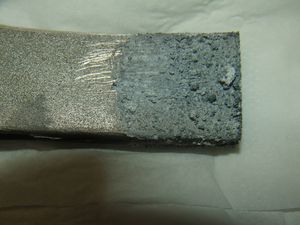
Published by LanthanumK
-
in
Experiments
April 2 2012
1
02
/04
/April
/2012
15:43
I have compiled a list of sources for the elements that are available to the amateur chemist. Palladium will be discussed here.
Palladium is a silvery-white precious metal from Group 10. It has a similar appearance to silver, but it does not decolorize and tarnish like silver does, therefore it can act as an expensive substitute. Palladium does form a range of coordination complexes, but is a relatively noble metal. Palladium was discovered in the early 1800s in platinum ores. It is quite similar to the other platinum group metals.
In element form: Some beads and jewelry are plated with palladium metal. Some spark plugs use palladium alloys.
In compound form: Multi-layer ceramic capacitors contain palladium in their contacts.
Here is my sample of palladium. It is some multi-layer ceramic capacitors.
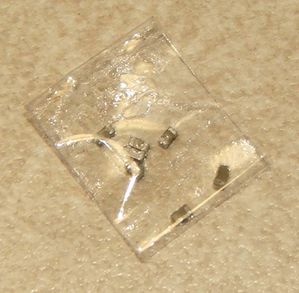
Published by LanthanumK
-
in
Elements
March 31 2012
6
31
/03
/March
/2012
14:04
I earlier tried to add hydrochloric acid to Pepto-Bismol. It decolorizes, but the solution remains too thick to allow for any extraction of the bismuth chloride solution. To fix this, I add Pepto-Bismol drops to a dilute hydrochloric acid solution and stir. The drops break up and decolorize, and the bismuth dissolves. The solution is filtered and reacted with zinc metal. The zinc metal turns black as a thin smear of bismuth forms on the surface.
However, although Pepto-Bismol is widely available and relatively cheap, this is not a good way to produce bismuth metal. The amount produced is so small and so finely divided that it just stains filter paper. Here is how the zinc looked.

Published by LanthanumK
-
in
Experiments
March 30 2012
5
30
/03
/March
/2012
20:27
I have compiled a list of sources for the elements that are available to the amateur chemist. Rhodium will be discussed here.
Rhodium is commonly regarded as the most expensive non-radioactive element in the world. (Some radioactive elements require millions of dollars to create one or two atoms, so they cannot be accurately compared to the stable elements.) Rhodium is a hard white shiny metal that forms an excellent plating on materials. This plating is ironically used in cheap jewelry because the amount of rhodium used is extremely small. Rhodium forms a wide range of aqueous oxidation states and complexes, like many other precious metals.
In element form: Much jewelry is rhodium plated and it is often advertised as such because it makes it sound valuable. Catalytic converters contain rhodium mixed with platinum which is what makes them so expensive.
In compound form: No sources found.
Here is my sample of rhodium. It is a reed switch advertised as having rhodium-plated contacts.

Published by LanthanumK
-
in
Elements
March 29 2012
4
29
/03
/March
/2012
15:04
I placed a piece of nickel metal from a spark plug in a moderately concentrated copper(II) sulfate solution and let it sit overnight. No reaction was observed in the morning.
I then placed the nickel in some water and added a copper(II) chloride crystal. It dissolved, leaving a highly concentrated layer of copper(II) chloride solution on the bottom of the vial. The nickel metal was right in this solution. It seemed that a tiny amount of copper was produced, but even if a reaction was occurring, it was so slow that it would take weeks to get any significant amount of copper from the nickel reaction. Even placement in a boiling water bath did not produce any reaction between the copper(II) chloride and the nickel metal.
Nickel is quite an inert metal, with an oxide coating protecting against oxidation to a significant extent. It seems that this oxide coating is quite resistant to copper compounds.
Published by LanthanumK
-
in
Experiments
March 29 2012
4
29
/03
/March
/2012
14:59
Silver is best dissolved by nitric acid, forming a colorless solution of silver nitrate. However, nitric acid is difficult to obtain, so acetic acid is used instead to dissolve it.
I dissolved some anodized (silver is made vulnerable, not protected, by anodizing) silver in acetic acid and hydrogen peroxide. It formed a milky solution of silver acetate (because of chloride impurities present in the vial). I then placed a piece of copper wire in the solution. Some silver formed as a black coating, but no silver crystals formed because of the insistent decomposition of hydrogen peroxide that was occurring from the copper wire. A purplish precipitate of what I assumed was micro-particulate silver accumulated on the bottom of the vial. When disturbed, it went into suspension. This same precipitate formed when ascorbic acid was reacted with the silver acetate solution.
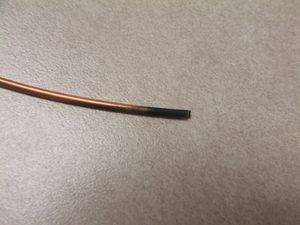
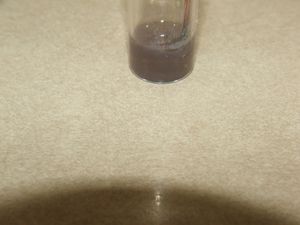 ae
ae
I also precipitated some silver carbonate. It formed as a fluffy white precipitate. Once filtered and dried, it turned brown as silver oxide or even elemental silver (from light exposure) was formed.
Silver acetate decomposes on exposure to light. After a day in daylight, the silver acetate was colored slightly bluish because of silver metal that had begun forming from the decomposition.
Because of working with this silver solution, I discovered that just about every piece of equipment I have for chemical experiments is contaminated with chloride ions.
Published by LanthanumK
-
in
Experiments
March 29 2012
4
29
/03
/March
/2012
14:52
I have compiled a list of sources for the elements that are available to the amateur chemist. Ruthenium will be discussed here.
Ruthenium is one of the lightest of the platinum group metals. Situated right under iron on the periodic table, ruthenium is a silvery gray hard metal. Like most of its neighbors, ruthenium is rather inert to attack by acids at room temperature. Actually, bleach will dissolve ruthenium while the most corrosive acids leave it untouched. From 2 to 11% of PGM ores consist of ruthenium. Ruthenium is one of the few elements that can form an octavalent oxidation state.
In element form: Ruthenium plating is used when a rather dark coating is desired. Electrical contacts are occasionally plated with ruthenium. Some tips of antique fountain pens contain a ruthenium alloy.
In compound form: Thick filim resistors commonly contain ruthenium dioxide.
Here is my sample of ruthenium. It is some thick film resistors from a circuit board.
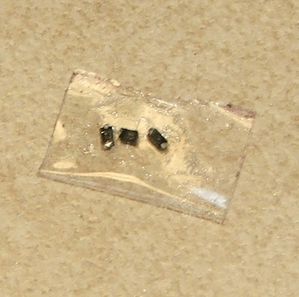
Published by LanthanumK
-
in
Elements
March 28 2012
3
28
/03
/March
/2012
15:42
Bismuth subcarbonate is formed by dissolving bismuth in a mixture of hydrogen peroxide and hydrochloric acid to form a colorless solution of bismuth(III) chloride. This is then reacted with sodium bicarbonate to precipitate white bismuth subcarbonate. The precipitate is filtered and dried. Some of this precipitate is placed on a piece of aluminium foil and heated. It turns black on the edges, then melts. The flame coming off the molten lump is slightly green. Once the lump cools, it is a yellowish color on the outside.
I then took another piece of dried bismuth subcarbonate and placed it on an iron loop. Again, it turned black and melted. I heated it until it was bright red hot and splashed it on the cold stove surface. The bead cooled to a yellow sphere (flat on one side) with bismuth metal visible on one end. It appears that the molten bismuth trioxide reacted with the iron wire to form iron(III) oxide and bismuth metal, which has a low melting point.
The bismuth subcarbonate decomposed to bismuth trioxide and carbon dioxide when heated. Bismuth trioxide melts at 817 C.
Here is the bead with the bit of bismuth metal visible.
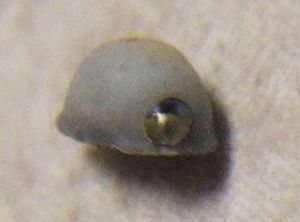
Published by LanthanumK
-
in
Experiments
March 28 2012
3
28
/03
/March
/2012
13:50
I'm sorry, technetium does not have any regularly available sources as it is a highly radioactive and dangerous element. You may see technetium as the radiation source for various medical procedures, but you will not be allowed to bring any home.
Published by LanthanumK
-
in
Elements








 ae
ae 
